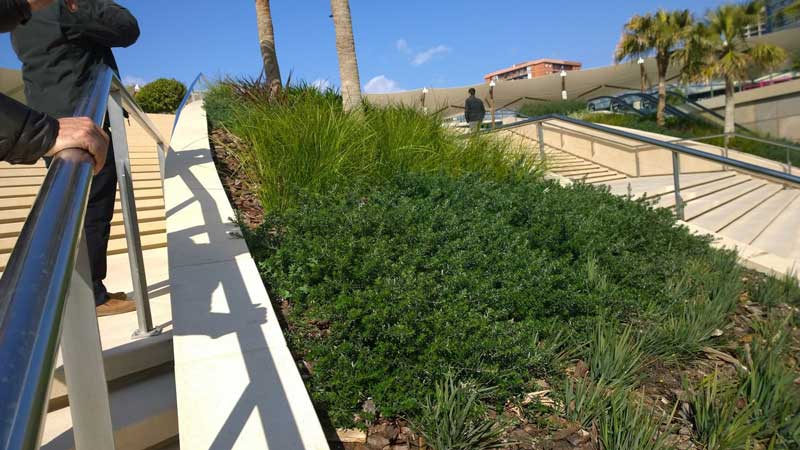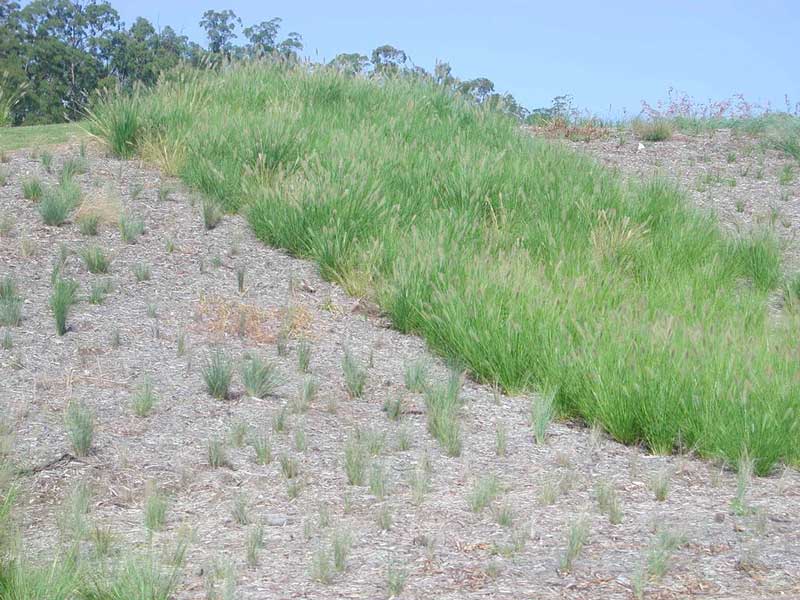Are you struggling to keep plants, soil and mulch on a slope without them washing away every time it rains? Landscaping on slopes presents unique challenges that can make it difficult to maintain a thriving diverse plant palette. Soil erosion, poor water retention, and plant stability are common issues when dealing with sloped terrain.
This article provides practical advice on designing, constructing and maintaining landscapes on slopes, as well as a list of some of the best shrubs and ground covers for steep, sunny sloped areas near retaining walls and pathways that reflect heat.

This steep slope features a low-growing shrub (Mundi™ Westringia fruticosa‘WES05’ PBR) and a strappy lomandra (Tanika® Lomandra longifolia‘LM300’ PBR). The mulch is being held in place with the help of plants, so it isn’t running down the hill too easily.
Why Choosing the Right Plants for Slopes Matters
Soil Erosion
On slopes, gravity continuously pulls soil downhill, leading to erosion.
Rain droplets hit the soil’s surface hard enough to displace soil. The rainwater then tends to run off quickly on slopes, carrying away topsoil and essential nutrients. When conditions are dry, the wind constantly blows soil away as long as it’s not secure beneath plants or mulch.
Water Retention
Sloped areas often have poor water retention as water runs off before it can soak in, and the soil profile is often too shallow to hold much moisture even after a big rain event. Plants may experience drought stress due to the quick drainage of water. Drip irrigation can help mitigate drought stress on slopes, without causing excess erosion like sprinklers can.
Nutrient Loss
Nutrients can easily be leached away by rainwater running off the slope. Over time, erosion reduces the amount of nutrient-rich topsoil available for plant roots. It can also expose existing roots, often causing them to die back and cause significant plant stress.
Root Anchorage
Slopes often have thinner soil layers with lots of rocks, making it difficult for plants to establish deep root systems. Minor landslides and soil slippages can uproot plants, especially without ground cover and with constant foot traffic.
Exposure
Slopes can have varying exposures to sunlight, with north and west-facing slopes generally receiving more sunlight each day than southern and eastern-facing slopes. This affects plants which should be tolerant to the harsh conditions, and it also affects bare soil which will degrade when exposed to the sun.
Slopes are often also more exposed to wind, leading to increased desiccation and physical damage to plants. Furthermore, the soil surface’s exposure to wind causes moisture to evaporate from the soil.
Water runs down slopes, causing erosion and preventing water from staying in the root zone. On top of this, rain droplets fall with enough force to displace the top layer of soil when hit directly, increasing erosion.

Slopes are difficult growing conditions, especially when there are lots of rocks and pavers to reflect heat like this. Luckily, the conditions are no match for Tasred® Dianella tasmanica‘TR20’ PBR which continues to thrive.
Characteristics of Ideal Plants for Slopes
Robust Root Systems
Plants with deep roots, long roots, thick roots, and fibrous root systems are all needed in synergy to stabilise soil. These robust root systems help anchor the plants securely and prevent soil erosion by holding the different soil layers together.
Groundcover Capability
Groundcover plants that spread to cover the ground are ideal for slopes. They protect the soil from sun, wind, and rain droplets, reducing erosion and maintaining soil moisture levels. This protective blanket over the soil prevents direct exposure to erosive elements, without falling down the slope like mulch.
Tolerance
Choosing plants that can tolerate dry conditions is a good idea for slopes without drip irrigation. Consider other landscape elements that may be reflecting light and heat, such as glass, rocks, and concrete, and factor these into your plant palette. Drought-tolerant and heat-tolerant plants are better suited to withstand the challenging conditions of sloped gardens, which are more likely to experience dry conditions than wet conditions (except in depressed parts of the landscape).
Ozbreed’s Erosion Control Research
Ozbreed’s erosion control research, led by Todd Layt and Ian Paananen https://www.ozbreed.com.au/best-plants-for-erosion-control/, focussed on identifying the best plants for erosion control. Starting in 2007 and continually updated, this study tests various plant varieties for their ability to strengthen soil using a Shear Vane tester. The research included growing ten large sample pots of each plant variety and conducting numerous shear vane tests to measure soil shear strength.
The findings showed that strappy leaf plants such as Lomandra, Dianella, Dietes, and Agapanthus, as well as native grasses like Pennisetum, significantly enhance soil stability due to their extensive root systems. For example, King Alfred® Dianella increased soil shear strength by 752%, achieving an undrained shear strength of 70 kPa compared to 9 kPa for unvegetated soil. Other notable performers included Katrinus Deluxe Lomandra, which strengthened soil by 366%.
The study demonstrated that plant breeding could significantly improve erosion control capabilities, as improved varieties consistently outperformed their common counterparts. This data is invaluable for landscape architects, engineers and erosion control professionals seeking plants that effectively stabilise soil.
Implications for Landscapers and Designers
For landscapers and designers, Ozbreed’s research provides concrete evidence on which plants are most effective for erosion control. Understanding which species offer the best soil strengthening properties can inform plant selection for various projects, including:
- Slopes and Batters: Plants with strong root systems can prevent soil slippage and erosion, maintaining slope stability.
- Stream Embankments: Effective erosion control plants can protect waterway edges from erosion due to water flow.
- Roadsides and Retaining Walls: Implementing these plants can enhance structural integrity and aesthetic appeal.
- Shorelines: These plants help fortify coastal areas against erosion from waves and tides.
Best Erosion-Controlling Plants for Sloped Surfaces
The plants in the list below have all been tester for their erosion controlling capacity and are resilient enough to thrive on a slope. Remember that not all slopes are equal, with some slopes in depressed areas experiencing periodic flooding, other slopes experiencing heavy frost, and others experiencing high humidity. Click the links to learn more about each plant. (**Links included in table**)
Plant |
% Increase vs bare soil |
Shear strength kPa |
King Alfred® Dianella |
752% |
70 |
Nafray® Pennisetum |
475% |
50.3 |
Lucia™ Dianella |
433.75% |
49.3 |
Katrinus Deluxe Lomandra |
366% |
39.6 |
Nyalla® Lomandra |
328% |
36.1 |
Breeze® Dianella |
297% |
33.2 |
Katie Belles™ Lomandra |
285% |
32.3 |
Tasred® Dianella |
250% |
29.6 |
Tanika® Lomandra |
250% |
29.5 |
Little Jess™ Dianella |
181% |
24.3 |
Little Rev™ Dianella |
161% |
22.8 |
Tropic Cascade™ Lomandra |
159% |
18.6 |
Fine Divine™ Dietes |
326% |
38.5 |
Grand Star™ Dietes |
228% |
26.9 |
Shara™ Lomandra |
225% |
26.2 |
Evergreen Baby™ Lomandra |
210% |
24.8 |
Pacific Sky™ Lomandra |
200% |
23.6 |
Flat Mat™ Trachelospermum |
140% |
16.5 |
Strategies for Plant Growth on Slopes
Terracing
Creating terraces involves constructing stepped levels on a slope to slow down water runoff and reduce erosion. Each terrace acts as a mini-plateau, capturing water and allowing it to soak into the soil rather than rushing downhill. This method creates flat planting areas, improving conditions for plants and making it easier to maintain them.
Covering Ground
Applying a cover on the soil can improve moisture retention and protect against erosion, and mulch is effective on gradual slopes. However, it may not be suitable for steep slopes where it can slide downwards. Ground-covering plants are ideal because they form a living mulch that anchors the soil while protecting its surface. Organic geofabrics can be used to hold the soil in place while groundcover plants establish.

Nafray® Pennisetum alopecuroides ‘PA300’ thriving on a slope.
Selecting Appropriate Species
Look for plants with vigorous roots and dense vegetation which are also tolerant of hot, dry conditions. Groundcover plants protect the soil surface from wind and rain droplets with their leaves and bind the soil together with their roots, which provide exudates that improve soil structure and feed microbes. Strappy ground covers like lomandras and dianellas often have the best erosion control capacities. Taller shrubs and trees have thicker roots that often penetrate deeper into the soil, working in synergy with the ground cover plants.
North-facing slopes receive more sunlight than south-facing slopes because of our location south of the equator and the sun’s pathway in the sky. Western slopes experience harsher afternoon sun, which is more intense than the increased exposure to the morning sun experienced on eastern-facing slopes.
Maintenance Strategies for Slope Gardens
Regular Inspection
Regularly monitor your slope garden for signs of erosion or plant stress. Exposed roots and soil displacement are indicators of potential problems. Drip irrigation may be a better option than sprinklers for slopes, as it delivers water directly to the roots without causing excess erosion.
Weeding
Weeds can slow down the growth of tubestock and young plants but can also help hold the soil together. Evaluate whether it’s really worth spraying and hand-weeding, or whether it’s best to simply regularly trim flower heads before they go to seed. This way, you can control weeds while still benefiting from their erosion-controlling properties.
Replenishing Ground Cover
Keep mulch layers refreshed to maintain their benefits on gradual slopes. Chunky mulch is best because it allows air and water to easily penetrate the soil while preventing weeds from taking hold. However, mulch may not be appropriate for steep slopes. In such cases, use geofabrics and groundcover plants instead to stabilise the soil effectively. Plant ground covers close enough together that they can meet and cover all ground. When plants die, understand why so that you can prevent it happening again and replace them swiftly.
Conclusion
Choosing the right plants for slopes is crucial for preventing soil erosion, managing water retention, and ensuring plant stability. By selecting plants with robust root systems, ground cover capability, and drought tolerance, you can create a thriving slope garden.
Implementing strategies like terracing, using organic geofabrics while ground cover plants establish, and regular maintenance are all methods to increase plant health and decrease erosion. Apply these practical tips to improve your sloped landscapes, to turn the tide on the forces of erosion and establish resilient and captivating garden designs.
